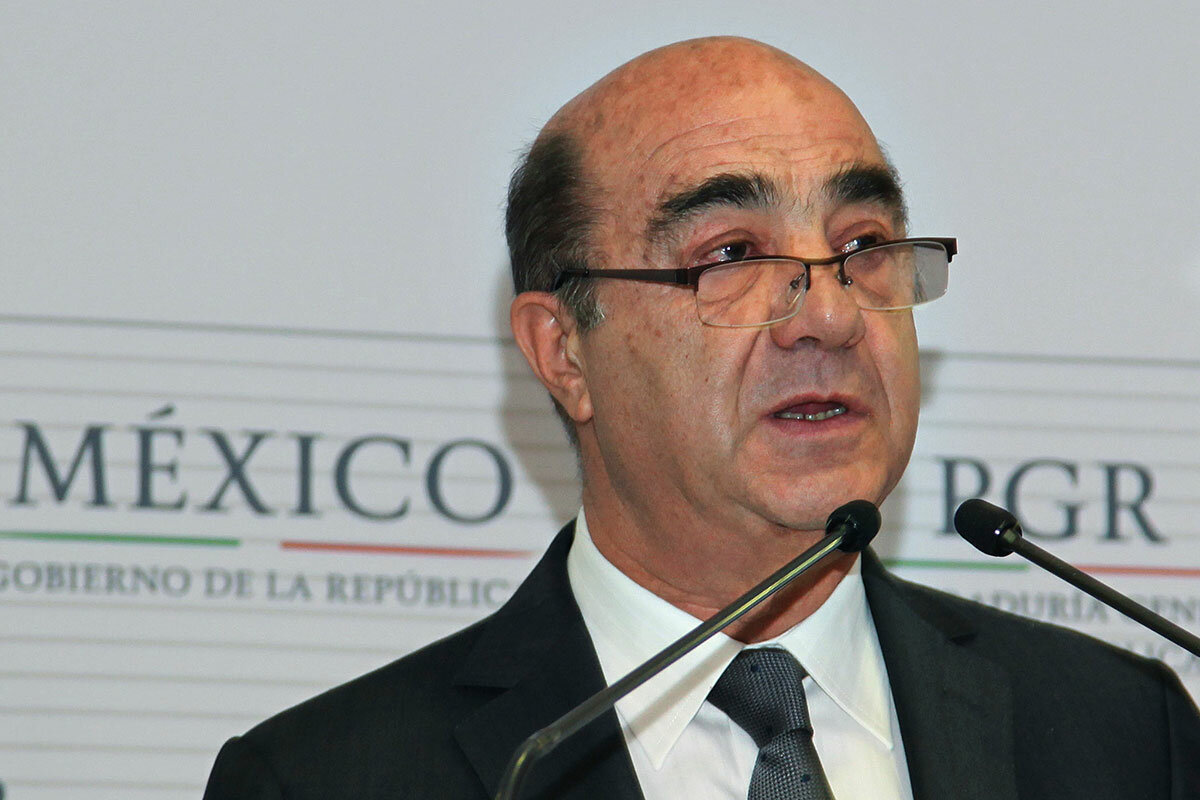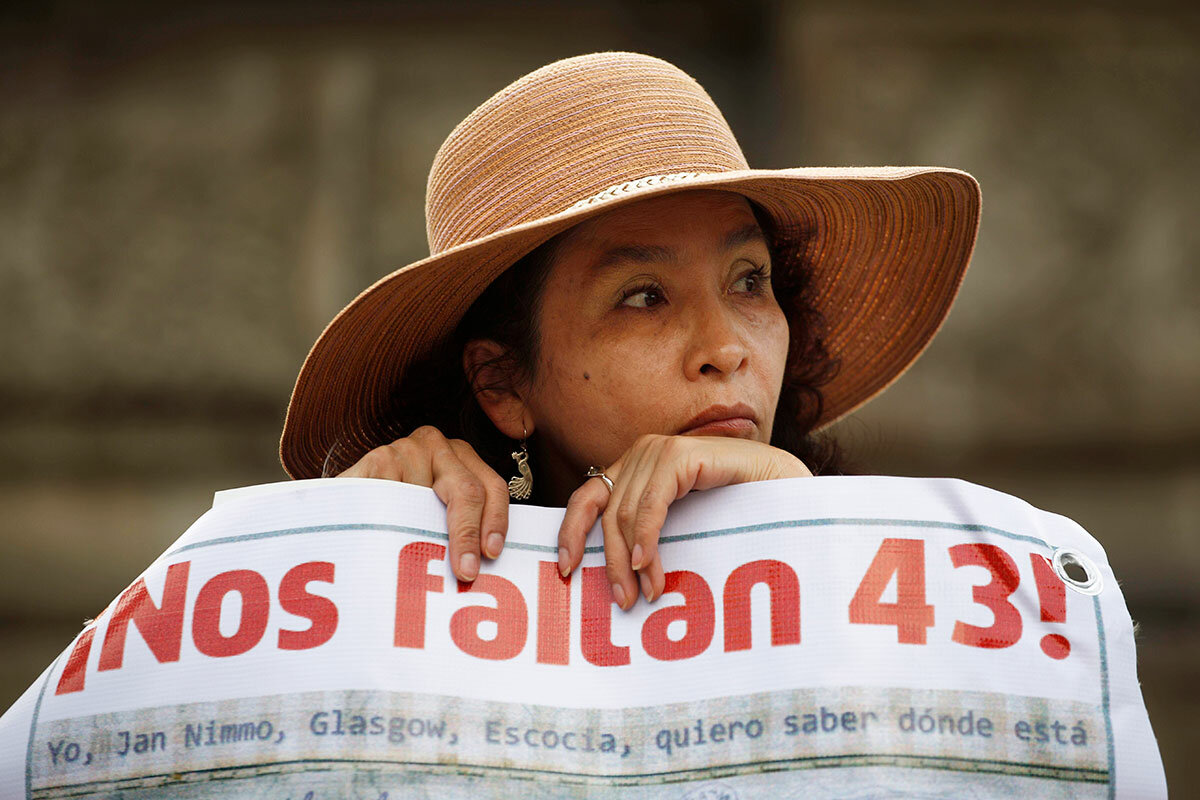Can a country restore trust after students disappear? Mexico takes responsibility.
Loading...
| Mexico City
For eight years, the families of 43 students who went missing in September 2014 have been clear about who they believe is responsible for the crime: “Fue el estado.” (“It was the state.”) The phrase is regularly featured on banners at public demonstrations and graffitied across streets and buildings in Mexico.
This month, a government official for the first time publicly agreed, labeling the haunting disappearances “a state crime.”
In the days following that announcement, former Attorney General Jesús Murillo Karam was arrested for his role in the initial investigation. At least another 80 arrest warrants have been issued for government officials – from local police to soldiers – and gang members implicated in the case.
Why We Wrote This
A story focused onA lack of justice breeds apathy. In Mexico, authorities have finally taken responsibility for a crime that rocked the nation – and in doing so could help regain public confidence in the system.
And just last week, Interior Undersecretary Alejandro Encinas, who heads up the case’s truth commission, took many by surprise once again by elaborating on the state’s involvement not only in the cover-up of what happened to the students but also in how it played a direct role in some of their deaths.
The Ayotzinapa case, named for the teachers’ school in the southern state of Guerrero, has gripped Mexican society, drawing thousands of protesters to the streets almost weekly in its immediate aftermath and monthly in the near decade since. The case became a symbol for widespread impunity, dishonesty, and lack of care for victims in the Mexican justice system.
Now that the government has taken some responsibility for it, the state has a chance to regain trust of the populace. There is still much more to be done, families and experts say – whether that’s actually seeing those responsible convicted for their crimes or identifying where any remains might be. Ultimately the implications of this case lie in whether the government offers lip service about responsibility or holds those responsible to account.
“If you see your justice system failing over and over and over again, then you lose faith. You feel there is no system,” says Kate Doyle, a senior analyst and director of the Mexico Project at the National Security Archive, a nonprofit housed at George Washington University in Washington. “But if this case actually leads to convictions, leads to the identification of remains, or changes in the law, then [it sends a message] that this can’t happen again. Even if it’s just one case, it helps people think about the system differently.”
“In my ... heart every day”
Protesters turned out in the pouring rain Friday carrying banners emblazoned with the boyish faces of the missing young men, all budding teachers. The energy was cautiously hopeful.
But for Mario González Contreras, who has marched down Mexico City’s main thoroughfare, Reforma, on the 26th of nearly every month since his only son’s unexplained disappearance, the demonstration didn’t feel different. His son, Cesar Manuel González Hernández, is still missing. It’s a reality that overwhelms him with pain, “rage, and anger that we feel month after month, day after day,” he says.
Nearly a decade later, a motive for the disappearances remains unclear, although most believe it’s connected to Mexico’s drug-fueled violence and that scores of student activists from the teachers’ college were inadvertently caught in the crosshairs. They were taken off buses by police in the town of Iguala. They’ve never been seen again.
Thanks to the interim report released by the Truth and Justice Commission on Ayotzinapa (COVAJ) this month, Mr. González knows more facts about the disappearance than he ever has. He knows which bus Cesar Manuel was riding on, which street the bus was stopped on, and that it was the local police who kidnapped him. That’s where the information ends, though – and it’s just not enough for Mr. González and his wife, Hilda Hernández Rivera.
“I’m going to keep searching for him with the same love and energy as always,” Ms. Hernández says. “I love my son and he is in my thoughts and heart every day and night, but the government just doesn’t understand that.”
The COVAJ report formally debunked former Attorney General Murillo Karam’s version of events, referred to by the former administration as the “historic truth” of the Ayotzinapa case. His story described all 43 students being brought to a garbage dump where they were supposedly killed and incinerated, with their ashes tossed in a river. The storyline has long been criticized as an attempt to quickly close a controversial case.
For Mr. González, debunking that theory was one of the most significant parts of the new report. “Murillo Karam caused us so much harm” with his version of the truth, he says. But more than just sitting behind bars, Mr. González wants to see Mr. Murillo Karam, who was arrested on charges of forced disappearance, torture, and obstruction of justice, share any information that he might have – such as who was carrying out orders and why.
Mr. Murillo Karam’s arrest wasn’t satisfying for Carlos Bravo Regidor, a Mexico City-based political analyst. “A lot of people will celebrate that he’s in jail. But in a country like Mexico, with so much impunity and manipulation of the justice system, putting someone in jail ... does not mean justice is being served,” he says. The same skepticism extends to acknowledging the state’s role in the tragedy.
“We are recognizing it’s a crime of the state – that’s great. But if that doesn’t come with actual names and evidence and an actual explanation of what happened, then it’s just empty rhetoric.”
Trust the army?
Additional revelations – some not included in the preliminary report – continue to trickle out. On Friday, Mr. Encinas shared that six of the Ayotzinapa students were allegedly kept alive in a warehouse for days following their abduction. The students were turned over to a local army commander, who then ordered their execution, Mr. Encinas said.
The role of the armed forces could be a complicating factor for President Andrés Manuel López Obrador, who pledged to resolve Ayotzinapa when he took office in 2018. Although the president campaigned on demilitarizing Mexico’s approach to public security, the armed forces have become central to his presidency, as soldiers carry out infrastructure projects or control migration.
Although public trust is high for the armed forces, confidence falls when they carry out tasks like controlling protests, a recent study shows. How this administration moves forward now that it’s become clear that the armed forces were intimately involved in the Ayotzinapa case could determine how much the public will continue to tolerate their role in everyday government tasks.
Transparent trials and convictions of military officials and others implicated will be central to progress, Ms. Doyle says. Until 2018, Mexico resisted setting up a truth commission, making it one of the few countries in Latin America – a region wrought with a complicated history of human rights abuses at the hands of the state – without one. The commission is imperfect – parents like Mr. González and Ms. Hernández wish it was in better contact with them, sharing report findings before making them public. But it could help create accountability.
“If this all ends with the status quo we have today,” of no real answers or criminals answering for their actions, “that will be crushing for Mexico, never mind personally for these parents,” says Ms. Doyle.
After nearly eight years without their son who had dreamed of becoming a teacher, Mr. González and Ms. Hernández aren’t waiting for anyone to provide answers for them. For three years, Mr. González participated with COVAJ as one of five family members. He participated in its searches scouring hillsides, rivers, and caves across Guerrero state in pursuit of answers. The couple have traveled the world, meeting with other social activists whose loved ones have been disappeared and Mexican communities in the United States that have supported their crusade for truth.
In many ways, they understand that the responsibility to find their son, who Ms. Hernández says “is still alive” until she sees scientific evidence to the contrary, falls on their shoulders.
“Hope dies,” Mr. González says, only “when one stops breathing.”







